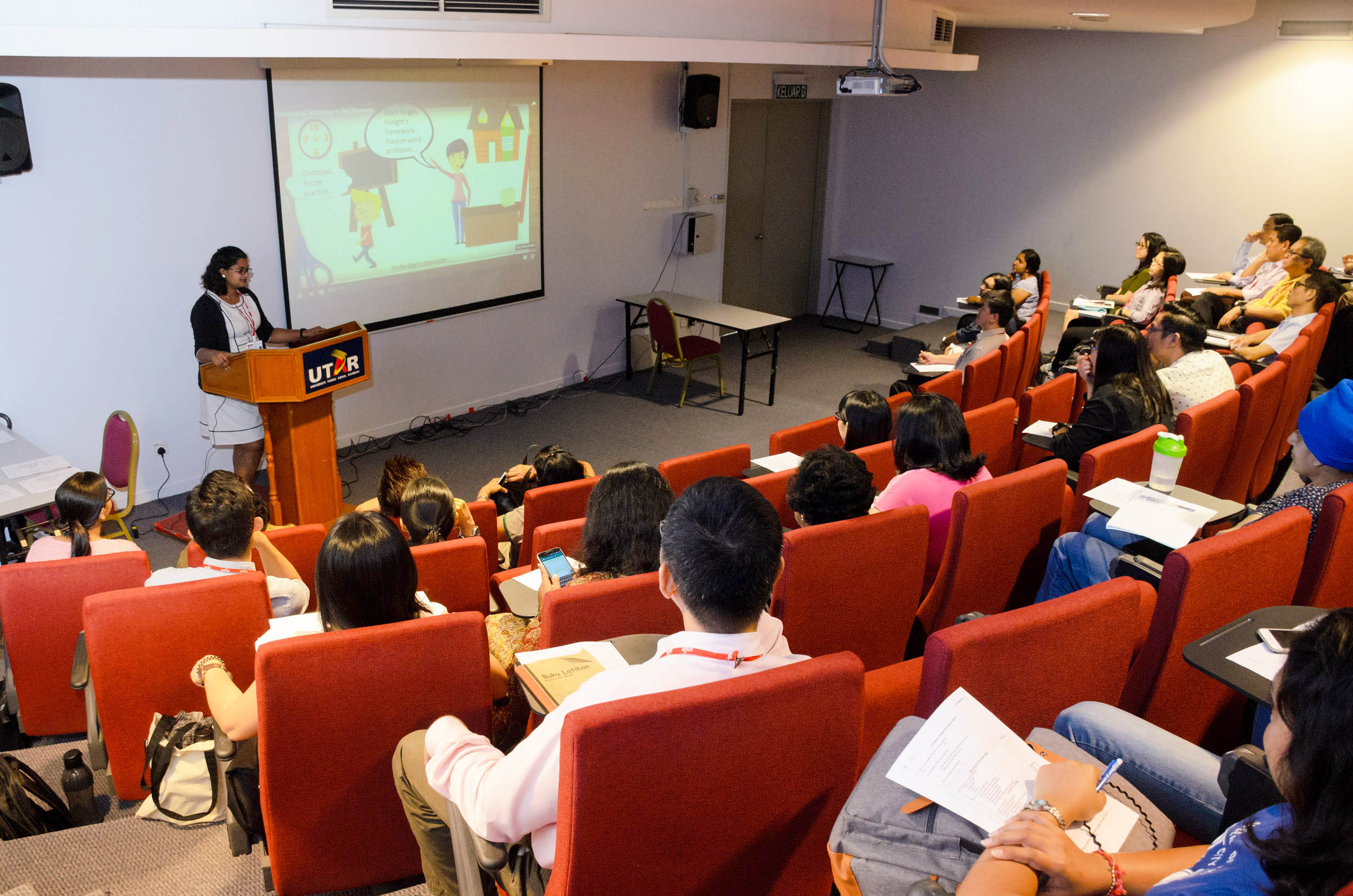
With the aim to educate UTAR academics and students about effective teaching and learning, the Centre for Learning and Teaching (CLT) successfully organised a talk titled “Blended Learning and the Future of Education” at Kampar Campus on 29 March 2018.
The invited speaker was Faculty of Arts and Social Science (FAS) lecturer Kristina Francis. The objective of the talk was to provide participants with an overview of blended learning and its importance as well as the ways on how to incorporate blended learning into the teaching and learning programmes.

Kristina delivering her insights on blended learning
The talk session started with an introduction to E-learning. There are few types of E-learning, among them are distance learning, the education of students who may not always be physically present at a school; hybrid learning, which combines face-to-face classroom instruction with online activities that reduces the amount of seat time in a traditional face-to-face course and moves more of the course delivery online; and blended learning, that combines online digital media with traditional classroom methods. Blended learning requires the physical presence of both educator and student, with some element of student control over time, place, path, or pace. Blended learning is considered as a unique approach that aims to develop quality education. Traditionally, in foreign practice they allocate six models of blended learning, namely face to face driver, rotation model, flex, online lab, self-blend and online driver.
Kristina explained, “In the field of education, the most frequently asked question is “what actually works” in order to enable students to learn efficiently. One of the current popular ways of teaching and learning would be adopting the blended learning approach, which allows the educator and students to thrive in their academic pursuits using advancements of educational technologies. Technologies should be utilised in the teaching and learning contexts. But, how are we going to implement that in the classroom? How are we going to design modern learning experiences for students? And in the perspective of students how are they going to react and respond?
Kristina further elaborated that, the use of blended learning environments in higher education has rapidly increased in the 21st century. Tools and techniques that were initially used in the experimental distance education courses are today part of mainstream education with blended learning as a continuum between traditional face-to-face teaching and purely online courses. Among the popular blended learning tools available online are TED-Ed, Google Classroom, PlayPosit, Edpuzzle, Blubbr, LessonPaths and Kahoot.
She described, “Blended learning is a combination of offline, namely face-to-face, traditional learning and online learning in a way that one compliments the other. Blended learning provides individuals with the opportunity to enjoy the best of both worlds. For example, a student might attend classes in a real-world classroom setting, and then supplement the lesson plan by completing online multimedia coursework. Creating a blended learning environment for students can be very challenging for the academics. However, blended learning is important because it breaks down the traditional walls of teaching, one that does not work for all students and now with access to present day technologies and resources we can tailor the learning experience for each student.”
In her talk, Kristina also spoke about the advantages of blended learning. She said, “Blended learning offers flexibility in terms of availability— anytime, anywhere. It provides access to global resources and materials that meet the students’ level of knowledge and interest. Apart from that, blended learning strategies also offer effectiveness and efficiency, besides providing a platform for students to develop their critical thinking and creative skills.”
She added, “Blended learning sounds like a dream for students and academics. Theoretically, class time is reduced, and the process of instruction is modernised through the use of technology. However, blended learning gives unique challenges that can become barriers to learning. Among the challenges are technological issues, inadequate exposure, inadequate training, lack of internet access and expensive technology.”
She concluded, “UTAR is one of the higher learning institutions that should emphasises on blended learning and its current focus is on the importance of education in the fourth industrial revolution. Blended learning will be a good platform for coping with the growing demands of education in the current wave of the industrial revolution. In addition, blended learning also promotes a shift towards lifelong and interactive learning in UTAR.”
Kristina is currently an academic staff member of the Department of Language and Linguistics of FAS, UTAR. A PSMB certified trainer, she has been involved in English language teaching and teacher training for over four years. Her core interest is focusing on the designing of flipped massive open online courses (fMOOCs) module based on higher order thinking skills (HOTs). Her expertise includes blended learning. She is experienced in the techniques of creating or developing meaningful and useful learning using Web technological tools.
© 2019 UNIVERSITI TUNKU ABDUL RAHMAN DU012(A).
Wholly owned by UTAR Education Foundation Co. No. 578227-M LEGAL STATEMENT TERM OF USAGE PRIVACY NOTICE